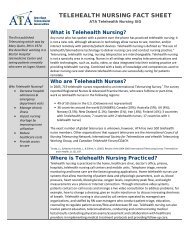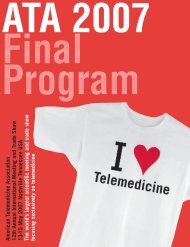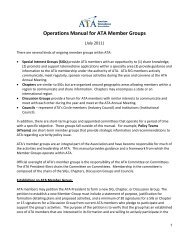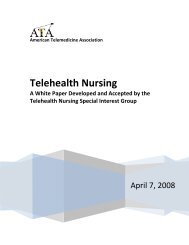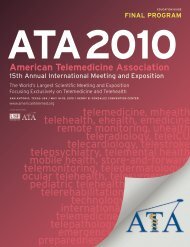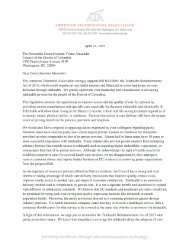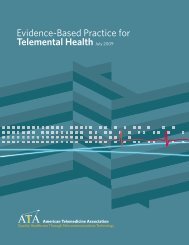Telemedicine
Presentation Abstracts - American Telemedicine Association
Presentation Abstracts - American Telemedicine Association
You also want an ePaper? Increase the reach of your titles
YUMPU automatically turns print PDFs into web optimized ePapers that Google loves.
CONCURRENT ORAL PRESENTATIONS ABSTRACTSmultiple team members, multiple technologies, and multiple levels of expertise.The ultimate responsibility falls onto the lead surgeon. A lead surgeoncan have 30 years of experience or 30 hours of experience after a residency.Currently, healthcare delivery does not distinguish between the two. Theculture of the operating room is currently focused on unique surgeon expertise,and not free-flowing collaboration that exists in many other industries.This free-flowing, supportive, and open ended collaboration will bemission-critical for all healthcare systems within the next 3 to 5 years.Avoidable surgical outcomes will drive this, such as unintended injuries tostructures, inability to remediate poor performing surgeons, and the inherentchallenges of distributing new knowledge about new technologies or newprocedures. Accountable care organizations and integrated delivery and financesystems will depend upon tele-mentoring in the procedural suites andmainly in the surgical suite to ensure high quality and cost effective care.Better surgical outcomes will potentially decrease readmissions, shorten lesslength of stay, increase patient satisfaction, and lessen the risk of transitionalcare. Specifically, examples of this would be one surgeon asking anothersurgeon to confirm a dissection plan, or one surgeon asking a colleague aboutthe extent of a cancer resection of surrounding organs, a junior surgeonasking the senior college for advice during a complicated case preventing anunnecessary conversion to an open procedure, or a senior surgeon asking ajunior surgeon about advice regarding a new procedure or technology that thejunior surgeon was specifically trained in. Accountability in healthcare reliesupon the multiple parties and stakeholders working together; with the risk andexpense being so high in the operating room in particular telementoring inthis domain will become mission critical and also a could potentially become acommercial resource for centers with domain expertise. This panel will discussall aspects of surgical tele-mentoring from a leader in surgical tele-mentoringtechnology, a leader and laparoscopic operating room integration, a leadingsurgeon with extensive surgical tele-mentoring experience, and a surgeonexecutive at one of the leading integrated and delivery finance systems wholeads their telemedicine and actively uses telemedicine in his practice.11:00 am–12:00 pm Monday, May 6, 2013INDIVIDUAL ORALSession Number: 008Session Title: POLICY ISSUES FOR MULTI-STATETELEHEALTHTrack: Policy Meeting Room 18 A/BMODERATOR: Gary Capistrant, Senior Director, Public Policy.American <strong>Telemedicine</strong> Association, Washington, DC, USA.147 LEGAL ISSUES IN TELEMEDICINE: OVERCOMING REGULATORYOBSTACLES TO A MULTI-STATE TELEHEALTH BUSINESSPRESENTERS AND CONTRIBUTING AUTHORS:Michael H. Cohen, JD, MBA, MFA, President.Michael H. Cohen Law Group, Beverly Hills, CA, USA.To create successful models of care, telemedicine businesses must satisfactorilyaddress critical legal issues, such as: state telemedicine and healthcareprovider licensing laws; HIPAA/HITECH rules; anti-kickback concernsgoverning healthcare payments; legal rules prohibiting false and deceptiveadvertising; malpractice and vicarious liability rules; and other relevantregulation.Legal risks to the telemedicine enterprise can come from various sources:i.e., healthcare providers who contract with the enterprise to provide telemedicineservices; site users who become patients of these providers; andfederal and state agencies, ranging from the FDA and FTC to state medicalboards, who find regulatory fault with the enterprise’s activities. Attention tostructure will help the telemedicine enterprise refine its operational modelachieve greater compliance with applicable legal rules. For example, somestates consider it a standard of care violation to provide diagnostic andtherapeutic advice online without a prior in-person encounter. Others willallow the provider to forgo a face-to-face physical exam for more routinemedical issues, unless, for instance, e-prescribing is involved. On anotherfront, liabilities to the enterprise can widely diverge, depending on whetherthe telemedicine venture represents itself merely a pass-through directory oflicensed providers, or an entity that stands behind its vetting and as such maybe potentially liable for negligence in credentialing. HIPAA and HITECHcompliance, as suggested, present another regulatory landscape requiringcareful attention, as the telemedicine business will likely be considered a‘‘business associate’’ of its featured healthcare providers, and as such, responsiblefor ensuring the privacy and security of PHI (protected health information).With respect to site content, advertising restrictions may limit howpractitioners can position themselves in an online capacity. Legal tools thetelemedicine business should understand include privacy and security policiesand procedures; careful design of flow of payments from site users and patientsto physicians and other healthcare providers, and, to the telemedicinesite provider; and strong contractual provisions to appropriate reign in itslicensee subscribers, or at least set clear legal boundaries to contractually limitrogue behavior by practitioners. Understanding these kinds of key legal issuesin depth can help telemedicine ventures create a defensive legal bulwarkagainst unwarranted liabilities, while proactively extending their businessmodels in an emerging marketplace.Objectives:1. Understand telemedicine licensing issues and learn to navigate variationsamong states.2. Resolve legal issues relating to standard of care in delivery of differentkinds of telemedicine services (including e-prescription).3. Understand HIPAA/HITECH issues and operational strategies for implementingrequired privacy and security safeguards.549 REGULATORY AND LEGAL DEVELOPMENTS IN TELEHEALTHPRESENTERS AND CONTRIBUTING AUTHORS:John D. Blum, JD MHS, School of Law.Loyola University Chicago, Chicago, IL, USA.The focus of this presentation will be on current, evolving areas of law andpolicy that are impacting telehealth. In particular, three aspects of legal andpublic policy development will be considered. The first area to be covered inthe roundtable concerns a review of state laws/regulations. The presenter willoffer an update and review of legislative and regulatory developments in all50 states, highlighting activities and trends since 2010. In addition, the presenterwill discuss pending state legislation in telehealth, based on informationgathered from state legislative council services from 2012/2013 filings.The second portion of the roundtable will focus on public policy developmentsin state health insurance exchanges regarding telehealth. The particular areato be explored will deal with how states that are actively developing exchangesare treating telehealth for purposes of complying with the AffordableCare Act, and related minimum essential health benefit requirements. It wouldappear in states that have enacted telehealth coverage mandates for privateinsurers (i.e. Virginia, Michigan, and California) that such mandates would beapplied to health plans listed on the exchanges. There is, however, consider-ª MARY ANN LIEBERT, INC. 2013 TELEMEDICINE and e-HEALTH A-37



